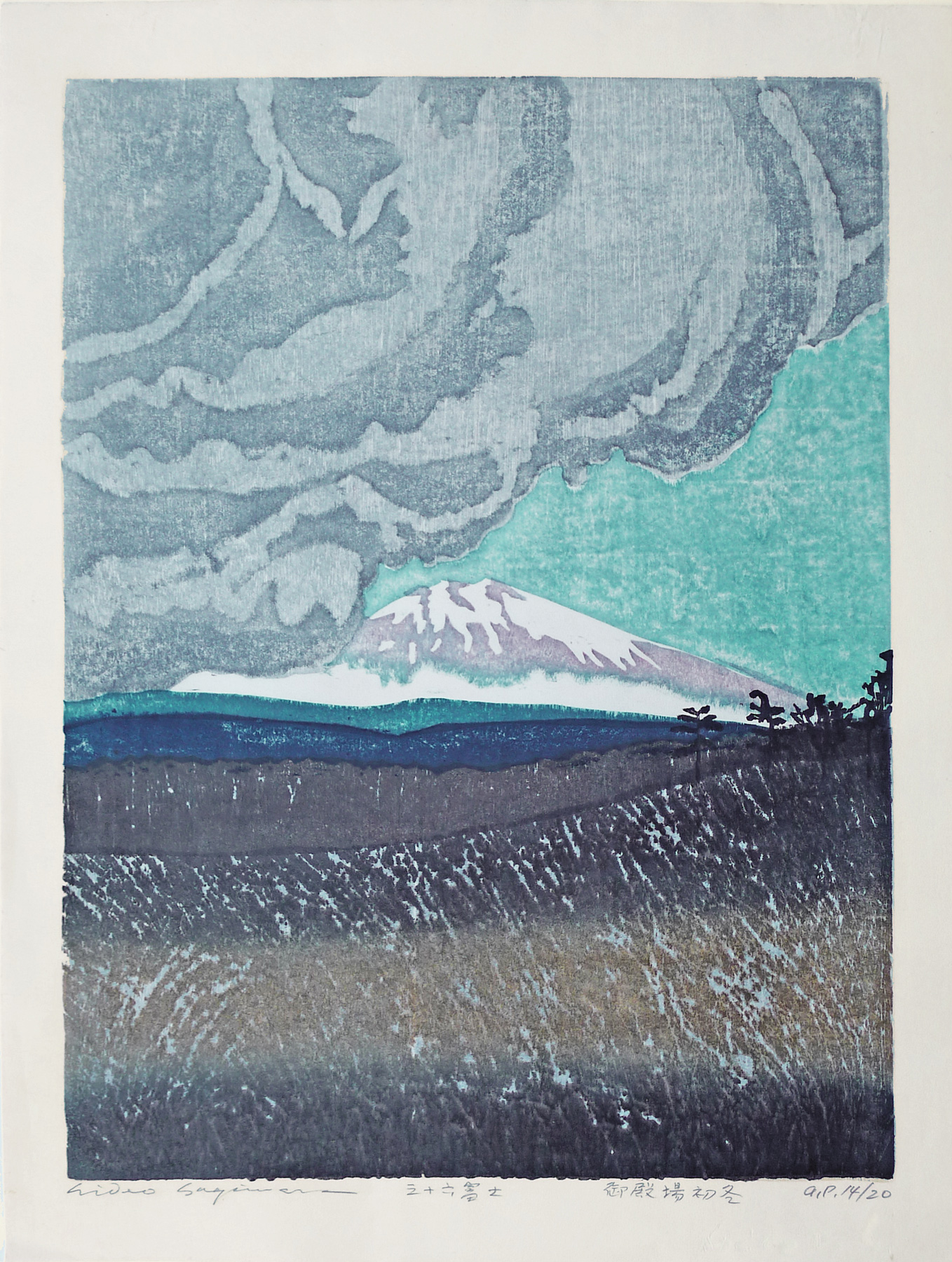About This Print
One of thirty-six prints created by Hagiwara as part of his series Thirty-six Fujis, created between 1981 and 1986. In this print Hagiwara pictures storm clouds rolling in, about to obscure an early winter clear view of Fuji from Gotemba on the southeastern flank of Mount Fuji. Hagiwara masterfully employs his unique color overlay technique to intensify his abstract coloration and a subtle dusting of ground mica highlights the colors.
萩原英雄 三十六富士:名残の花 Hagiwara Hideo (1913-2007)
Remains of Flowers,
from the series Thirty-Six Fujis1981/1986
Color woodblock print with embossing on paper
Lent by Irwin Lavenberg, L2018.62.6Living near Mount Fuji, Hagiwara gathered his impressions of the mountain for over fifteen years before beginning work on this series. Toward the end of the project he wrote: “Just when I think I have grasped [Fuji], it slips through my hands. Let's pick up this ‘slippery Fuji’ and keep on going.”
Sanjūroku Fuji 三十六富士 (Thirty-six Fujis)
Hagiwara created this series between 1981 and 1986, although it was many more years in the planning. It is the artist's homage (some say "challenge") to the famous ukiyo-e print artist Katsushika Hokusai and his Thirty-six Views of Mount Fuji (富嶽三十六景 Fugaku Sanjūrokkei) created in the early 1830s. But, whereas, Hokusai's views all include human activity, Hagiwara's thirty-six views focus on seasonal and atmospheric changes without directly showing the presence of man.
Special techniques used in the production of this series include kirazuri , the sprinkling of mica dust onto a light film of glue on the surface of the print while the ink is wet to achieve a subdued sparkle, the application of sawdust onto the woodblock to achieve an uneveness in the ink, and the use of varnish. To achieve Fuji's crown of snow, Hagiwara employed the technique of kimekomi (blind printing) a way of pressing out the paper to give a sense of volume.
In discussing why this series took so long to produce, Hagiwara states that while he was very familiar with the mountain, living in Kofu City, Yamashi Prefecture, "Mount Fuji looks like a beautiful mountain without faults, a beautiful woman without faults is very hard to paint."
Hagiwara's international reputation rests on the abstract woodblocks, bursting with saturated colour and rich in texture, that he has produced since 1958. The Thirty-Six Views of Fuji, his unique venture into landscape, nevertheless carries over may of these prized qualities... The artist announced in 1979 that he had already been out collecting ideas for the series in the vicinity of Fuji for 'ten years and more' and that he had commenced preparing the blocks 'the year before last'. Nevertheless he was finding it very difficult to complete the project: modern transport had expanded the number of places for viewing Fuji so much that this was perplexing him. These sentiments were echoed in the postscript to the publication that accompanied the completed set in 1986, in which Hagiwara wrote that the project had taken him twenty-five years: 'Just when I think I have grasped [Fuji], it slips through my hands. Let's pick up this "slippery Fuji" and keep on going.'1
1 100 Views of Mount Fuji, Timothy Clark, Weatherhill, 2001, p. 68.
List of Prints and Thumbnails [to view thumbnails go to Asagiri noyaki (Morning Mist, Burning Fields) from the series Thirty-six Fujis]
Sora moeru 空燃える (Burning sky)Hana kasumi 花霞 (Cloudy weather in spring)
Ishiwa sōshun 石上早春 (Early spring at Ishiwa)
Izu un'en 伊豆雲煙 (Smoky clouds at Izu)
Yama mata yama 山又山 (Mountain after mountain)
Biru no tanima ni ビルの谷間に (Among skyscrapers)
Misaka zangetsu 三坂残月 (Pale morning moon at Misaka)
Kawaguchiko Tasogare 河口湖黄昏 (Twilight at Lake Kawaguchi)
Baien no kanata ni 煤煙の彼方に (Beyond the smoke)
Kagosaka bojō 篭坂慕情 (Longing at Kagosaka)
Kenkyō kinshū 県境錦秋 (Autumn colors at prefectural borders)
Oyama wa koyake お山は小焼 (Glowing mountain)
Gotenba shotō 御殿場初冬 (Early winter at Gotenba)
Print Details
| IHL Catalog | #1625 |
| Title or Description | 三十六富士 御殿場初冬 [as inscribed on print] Gotemba shotō (Early Winter in Gotemba) |
| Series | Sanjūroku Fuji (Thirty-six Fujis) 三十六富士 |
| Artist | Hagiwara Hideo (1913 - 2007) |
| Signature | hideo hagiwara - pencil signed by artist in English in lower left margin |
| Seal | |
| Publication Date | 1981-1986 |
| Edition | a. p. 14/20 |
| Publisher | self-published |
| Carver | self-carved |
| Printer | self-printed |
| Impression | excellent |
| Colors | excellent |
| Condition | excellent |
| Genre | sosaku hanga (creative print) |
| Miscellaneous |  |
| Format | dai-ōban |
| H x W Paper | 21 x 15 3/4 in. (53.3 x 40 cm) |
| H x W Image | 18 x 13 3/8 in. (45.7 x 34 cm) |
| Collections This Print | |
| Reference Literature | Gendai mokuhanga no kyoshō Hagiwara Hideo no sekai: Shōwa 61-nen 5-gatsu 24-nichi--6-gatsu 29-nichi, Yamanashi Kenritsu Bijutsukan, 1986, cat. no. 127. |


